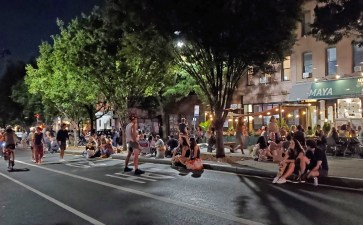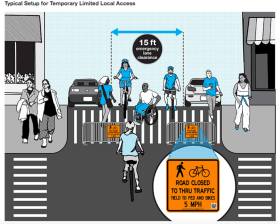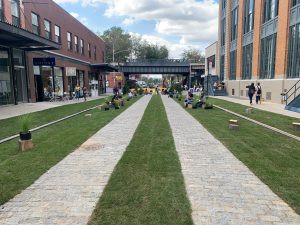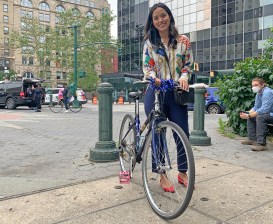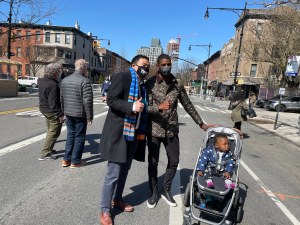Open Streets Coalition to Mayor: Give Us a Real Program (And Some Help)!
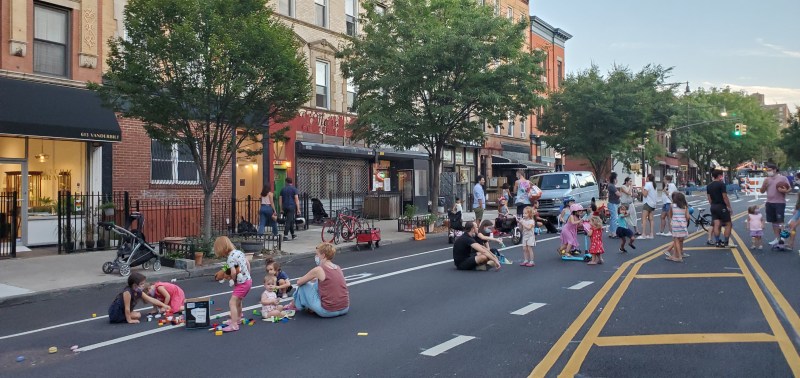
What’s the plan?
Dozens of volunteer groups that have been maintaining the city’s open streets program are demanding support from the city to ensure that the public space initiative — which has given hundreds of thousands of New Yorkers the ability to get outside and reconnect with their neighbors without the constant threat of violence from car drivers — is expanded in an equitable manner.
The mayor’s announcement of a streamlined application process for permanent open streets fell far short of creating a real program, the group said in a letter to City Hall today (the letter is real, despite the date of April 1 on it).
“We are concerned that your latest announcement still does not set up the open streets program to achieve its full potential,” said the letter, which is signed by the “Open Streets Coalition,” a collection of scores of volunteer groups that is being led by Transportation Alternatives.
Specifically, the group is demanding:
- City funding so that volunteer groups can hire staff: “Managing open streets has become more than a full-time job for many of the organizers, who have to manage daily operations of setting up barricades, volunteer coordination, social media, weather/safety monitoring, and sometimes even vicious attacks perpetrated by the vocal minority of New Yorkers who do not support the program. It is unsustainable for the program to be managed by volunteers in the long run.”
- Equity: “We are concerned that the uncertainty around funding for open streets will lead to a lack of open streets in neighborhoods that are historically under-resourced — predominantly communities of color. A more concrete plan for how Open Streets will be funded will encourage a more diverse group of communities to apply.”
- Permanent designs that would be self-enforcing: “Installing permanent infrastructure, permanently redesigning streets (such as installing mid-block dead ends, building bump-outs at corners), and changing traffic patterns would send a signal that open streets are a long-term, ingrained part of a neighborhood. They are also much more effective than temporary barriers.”
- Simpler permitting for programming: “Open streets have been a fantastic opportunity for communities to experiment with creative public programming. … However, DOT has instructed open streets groups that they will have to obtain permission from the Street Activity Permit Office for any programming going forward. This requirement could extinguish the ability for local groups to serve their communities with outdoor programming that has fulfilled a real need during the pandemic.”
“We hope that these suggestions serve you as we continue fighting COVID-19 and building a safer, more liveable city,” the letter concluded. “As the city recovers from the pandemic, open streets must be seen as a tool to maintain physical distance, a cornerstone of vibrant communities, and a priority for our city budget, newly infused with funding from President Biden’s American Rescue Plan.”
The letter comes on the heels of months of frustration and confusion about the city plans to roll out open streets, which Mayor de Blasio said in his State of the City address would be “permanent.” The definition of “permanent” remains unclear, given that the mayor has not detailed what such roadways would look like — beyond merely announcing that volunteer groups must reapply and continue to do their work.
Volunteer groups — and Borough Presidents Gale Brewer of Manhattan and Donovan Richards of Queens — have blasted the mayor for creating a “program” to add important open space to the city, yet not putting any city muscle behind it.
Meanwhile, Council Member Danny Dromm says he has not gotten a commitment from the city about its plans for the 34th Avenue open street in Queens, which city officials have repeatedly called “the gold standard” of open streets. The DOT has held several “visioning” workshops with residents, but Dromm says he has not been told if the city has a plan for making the roadway permanently car free, as he has demanded.
City Hall did not have an immediate comment on Thursday, but in the past, the mayor has said that he is open to providing some neighborhoods with permanent car-free space.
“We’re going to be looking more and more at the future of the city in terms of having as much open space as possible,” he said earlier this week. “Sometimes it’s going to be done in a temporary way. Sometimes it will be done in a permanent way. We should look at all of it. But what we do know is a lot of changes are happening in the streetscape and that’s for the good. Open streets have worked. Open restaurants have worked. More and more, we’re going to be using our space differently. This is a beginning, but I think there’s lots of potential going forward. So, we’re looking at a lot of options and I will not make news before it’s time, but we continue to look at a lot of different options.”
It’s not the first time Transportation Alternatives has tried to prod the mayor into fulfilling the potential of the open streets initiative, which has been mostly left in the hands of volunteer groups (or, in wealthy neighborhoods, paid staff) operating with little oversight and seeking a true permanent solution to the menace of cars.
In July, the group issued a report about the program’s shortcomings that emphasized the inequitable distribution of open streets, and offered recommendations.
Open streets, the report said, could have been “a serious tool to support our city’s recovery and transportation needs,” but instead it is a “disconnected network of public space islands with management challenges” that favors well-to-do areas.”
Here’s the letter sent to City Hall today:
